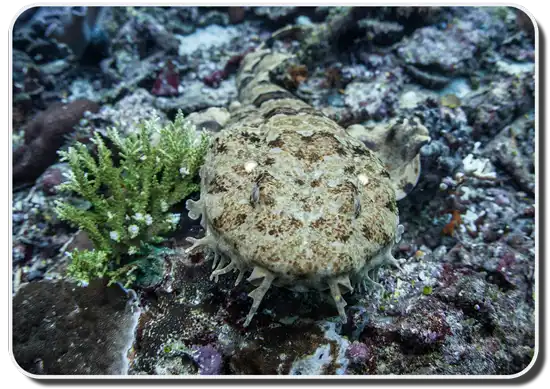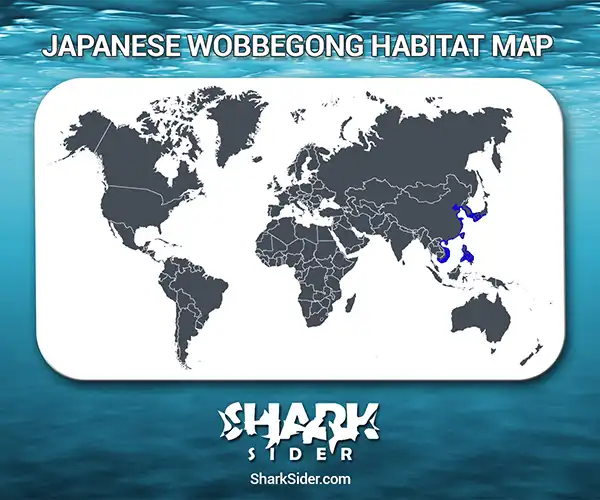The Japanese Wobbegong (Orectolobus japonicas) is a flattened, funny looking fish whose home is the temperate and tropical waters of the western Pacific Ocean. This is a Carpet Shark (Order Orectolobiformes), one of 12 species that belong to the Wobbegong family (Orectolobidae). Equally funny is its name: the quirky word is believed to come from an Australian Aboriginal language. Apparently it means “shaggy beard”, in reference to the skin growths around the mouth. (It’s fun to say too, try it! “wob-be-gong”, rhymes with hop-along).

Other features contribute to this creature’s odd appearance. It has spiracles (modified gill slits, to help breathing) that are larger than its eyes. There are also long, fleshy projections (barbels) around the mouth and nostrils that are thought to aid in feeding.
Like its family members, this small shark has a body shape and color pattern that are perfectly adapted for hiding on the sea floor. The skin is light with a pattern of lines and darker “saddle” markings. Little is known about the life history. Adults grow up to 1m (3.33 ft) long.
Japanese Wobbegong Facts
These sharks have many adaptations for staying camouflaged. In addition to their shape and color, they have a broad, flattened head. There are typically 5-6 skin growths that stick out on the sides of the head, below and in front of eyes. These “dermal lobes” obscure the body outline when the fish are lying on the sea bottom.
Similar to most modern-day sharks, Wobbegongs are thought to have originated in the Mesozoic era. A recent genetic analysis (Corrigan & Beheregaray 2009) showed that the entire Family diversified rapidly during the Miocene epoch, within the Indo-Australian region of the world. Surprisingly, this occurred relatively recently in terms of evolutionary time, over the last 2 million years. That is not much time at all, compared to the ancient, 400 million year old lineage of sharks as a group!
Habitat and Range
Map Of The Japanese Wobbegong Shark’s Habitat

The Japanese Wobbegong occurs in the Northwest Pacific, from Japan, China and Korea to Vietnam, and possibly the Philippines (although that may refer to an additional Wobbegong species). This bottom dweller prefers sandy/rocky surfaces and coral reefs, the substrates that match its cryptic coloration. It can be found from the intertidal zone to depths of about 1-200 m (330-660 ft).
Feeding Behavior
Though sluggish, these nocturnal sharks are ambush predators: they use their camouflage to sneak up on their prey. Heavy jaws and sharp teeth are powerful weapons for this mode of hunting.
Wobbegongs are weak swimmers; they can walk along the bottom using their paired fins, and can even climb out of water to move between tide pools!
They feed on invertebrates and fish that live on the ocean bottom, and they will also eat skates and shark egg cases.
Social Behavior
No information was encountered, but based on what is known about other Wobbegong species, this shark probably spends most of the time on its own.
Breeding
These sharks are ovoviviparous, giving birth to up to 20 pups in a litter. The neonate sharks are about 20 cm (8″) long. The gestation period last for roughly 12 months in captivity.
Humans and Conservation
Wobbegongs are considered to be potentially dangerous because of their strong teeth, and the fact that they have been known to bite people when stepped on.
These sharks are readily kept in public aquaria and have bred successfully in captivity. They are caught for food in many places throughout their range, and their attractive skin may be used for leather.
The IUCN Red List classifies the Japanese Wobbegong as “Data Deficient” because so little is known about its populations and life history. Of particular concern, however, is the fact that the species distribution overlaps with areas known to be exploited by trawl fisheries, where declines in other Wobbegong species have been observed. More information about the general biology and catch levels of this species is required for a proper assessment.
Written By: Kara Levevre
Sources
- Corrigan S & Beheregaray LB (2009). A recent shark radiation: molecular phylogeny, biogeography and speciation of wobbegong sharks (family: Orectolobidae). Molecular phylogenetics and evolution 52: 205-216.
- FishBase
- Florida Atlantic University
- Tanaka S, Nakaya K, Wang Y & Alava M (2009). Orectolobus japonicus. In: IUCN 2012. IUCN Red List of Threatened Species. Version 2012.2.
- Wikipedia
